 |
 |
 |
| |
Switch from Kaletra to Reyataz (SWAN Study 48 weeks): lipids, viral suppression
|
| |
| |
Reported by Jules Levin
poster TH PE 0123
XVI International AIDS Conference, 13-18 August, 2006, Toronto, Canada
Efficacy and Safety of Atazanavir (ATV) Based HAART in Virologically Suppressed Subjects Switched From Lopinavir/Ritonavir (LPV/RTV) Treatment
(Subset Analysis of the SWAN Study)
Gatell JM,1 Branco T,2 Sasset L,3 Pulido F,4 Macor A,5 Gothelf S,6 Gruber C,7 Odeshoo L,8 Wirtz V,8 Ledesma E9
1Hospital Clinic, Infectious Diseases and AIDS Unit, Barcelona, Spain; 2Hospital Do Desterro, Servico de Medicina, Lisbon, Spain;
3Ospedale Cittadella, Padova, Italy; 4Hospital Doce de Octubre, Unidad de VIH, Madrid, Spain; 5Ospedale Amedeo di Savoia,
UO Prevenzione Rischio Infettivo, Torino, Italy; 6Bristol-Myers Squibb, Global Medical Affairs Virology, Lawrenceville, NJ,
United States; 7Bristol-Myers Squibb, Central Division Operations, Braine-l'Alleud, Belgium; 8Bristol-Myers Squibb,
Biostats Antivirals, Wallingford, CT, United States; 9Bristol-Myers Squibb, Global Clinical Research - Virology,
Wallingford, CT, United States
The SWAN study (BMS 097) demonstrated that switching from PI ± RTV-containing regimens to unboosted ATV-containing regimens maintained virologic suppression with improvement in plasma lipids through 48 weeks.1
The objective of this post-hoc analysis was to assess the safety and efficacy of ATV based HAART in virologically suppressed patients switched from LPV/RTV treatment in the SWAN study.
Author Conclusions:
Among patients receiving an LPV/RTV-based regimen, a switch to ATV (± RTV)-based regimens:
- Resulted in comparable antiretroviral efficacy and improvements in plasma lipids, compared to patients who continued on LPV/RTV
- Did not increase discontinuations due to AEs
Both treatment arms were generally well tolerated and overall safety was comparable:
- Patients on ATV reported fewer gastrointestinal symptoms and more hyperbilirubinemia
- Patients switched to ATV had improvements in lipid parameters and received fewer lipid-lowering agents.
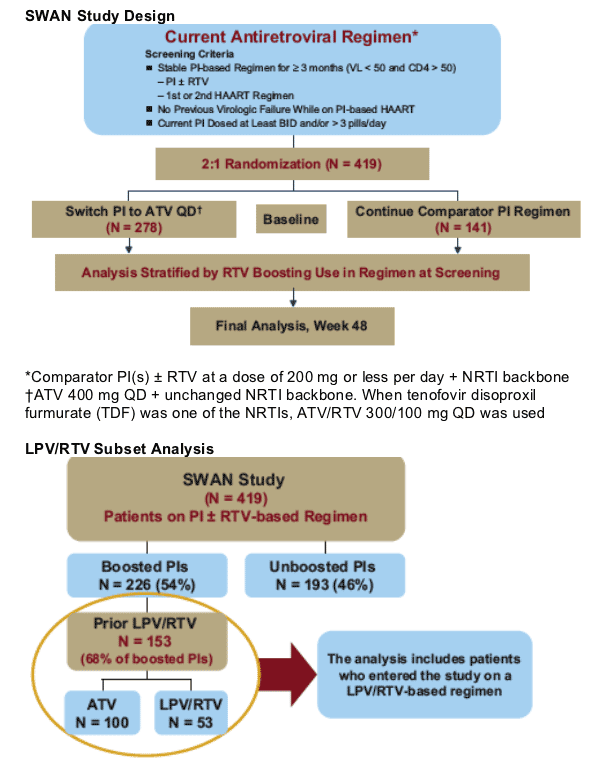
Post-hoc Analysis (LPV/RTV Subset)
Similar analyses were conducted on the LPV/RTV subset as were performed on the overall SWAN population
Efficacy
The proportion of patients with virologic rebound at or prior to Week 48
-- Confirmed on-study HIV RNA ≥ 50 copies/mL or last on-study HIV RNA ≥ 50 copies/mL followed by discontinuation.
The proportion of patients with treatment failure for any reason at Week 48
- Includes virologic rebound, never initiating study therapy or discontinuation of study therapy
Safety
The frequency and severity of clinical adverse events (AEs) (all grades, Grade 2-4), laboratory abnormalities (Grade 3-4), serious adverse events (SAEs), and discontinuation due to AEs
Lipids
Mean percent changes from baseline in total cholesterol (TC), fasting low-density lipoprotein cholesterol (LDL-C), high-density lipoprotein cholesterol (HDL-C), non-HDL-C, and fasting triglycerides (TG). Data were excluded after the start of lipidlowering therapy
RESULTS
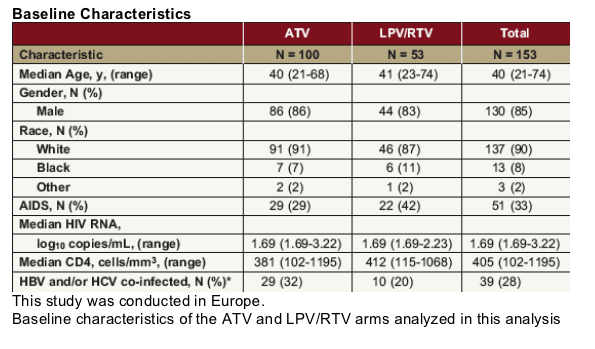
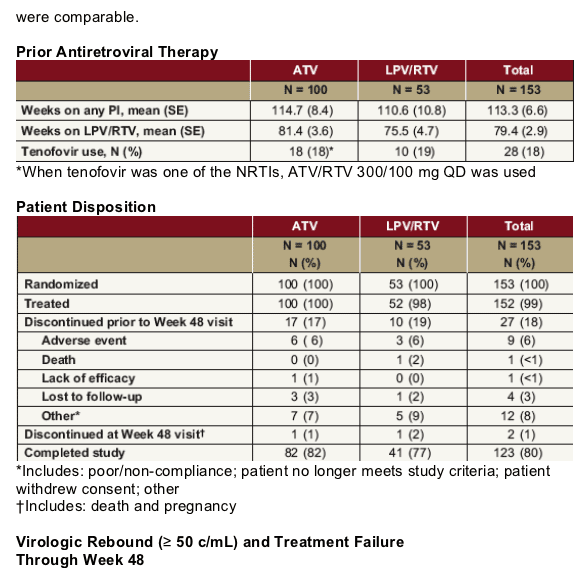
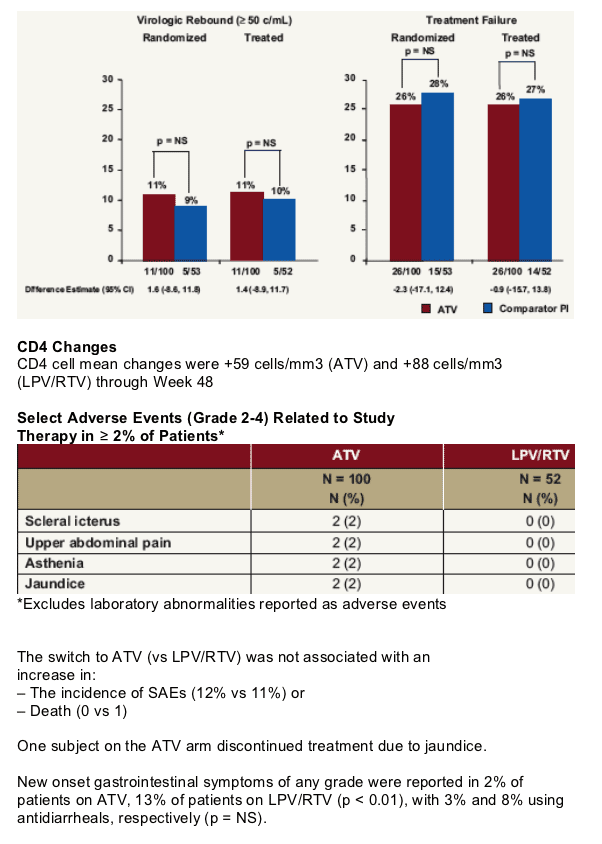
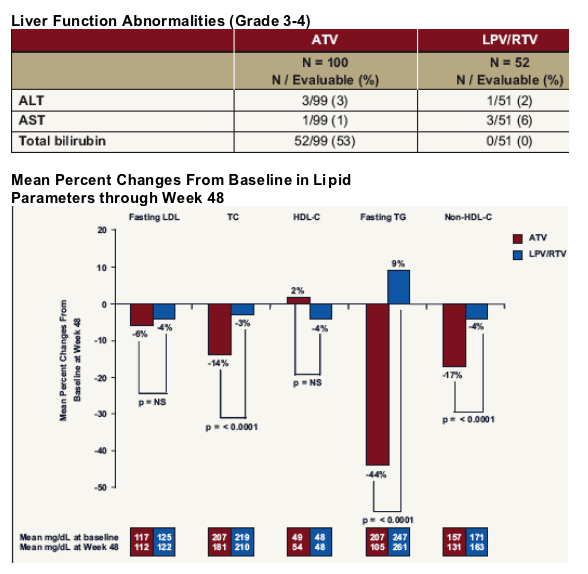
Improvements in non-HDL-C, TC, and fasting TG level were significantly higher for ATV compared with LPV/RTV (all p < 0.0001).
Lipid-lowering agents were used less often by ATV treated patients than those treated with LPV/RTV (8% vs 21%; p < 0.05) through Week 48.
Reference
1. Gatell JM, Salmon-Ceron D, Lazzarin A, et al. Efficacy and safety of
atazanavir (ATV)-based HAART in patients switched from a stable boosted
or unboosted protease inhibitor (PI) treatment. Presented at: 10th
European AIDS Conference; November 17-20, 2005; Dublin, Ireland.
|
| |
|
 |
 |
|
|